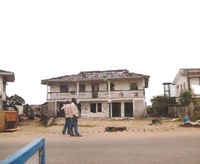Update Report on Port Harcourt demolitions
This Report is given based on follow-up activity by the National Union of Tenants of Nigeria, which includes visits to the area and interviews with the affected persons. The Report will be update to include the living conditions of the affected and suggestions on how they could be assisted to alleviate their plights and prevent a reoccurrence.
UPDATE REPORT
on
PORT HARCOURT DEMOLITIONS
(Njemanze Street)
26th October – 3rd November 2009
Background Information
Njemanze Street is one of the major streets that fall within the 2km radius of the Silverbird project. Stretching directly opposite the project, where it maintains boundary with Abonnema Wharf Road, the street runs backwards and terminates at Awgu Waterfront, which situates at the leftward axis along with Abonnema Wharf, Njemanze and Elechi Beach Waterfronts, all of which fall under the ownership claim of the people of Okrika. Ahead of the terminal end of the street is a pathway joining the street with Udi Street, both of which form the controversial boundary between the Ikwerres and the Okrikans. While the Okrikans lay claim on the entire land with the 29 waterfronts at the leftwing, the Ikwerres claim ownership of the entire land with the 12 waterfronts at the rightwing. At the terminal end of Udi Street is an extension of Elechi Beach waterfront linking Udi Street with the “ demolished” Urualla Market and stretches across Iloabuchi to Azikiwe Street and finally hooks up with Aba Expressway to make way for the proposed ring-road joining the expressway diagonally to the Silverbird Project.
At the right wing of Njemanze Street, is a vast land, comprising three streets namely Nsukka, Anokuru and part of Udi Streets and the education Bus-Stop axis of Port Harcourt, all of which form part of the 2km radius of Silverbird Project. Across the front axis of Njemanze Street is the Isaac Boro Park and its adjoining street namely Sangana, both of which also fall within the definition of the 2km radius of the Silverbird and, if joined with the other areas, constitute upto one-fifth of the total land area of Port Harcourt and a population of over 280,000 persons or about one-third of Port Harcourt total population.
About Njemanze Street
As one of the major double-lane streets in Port Harcourt, Njemanze Street provides a byway to major parts of Diobu and serves the need of commuters plying the Diobu-Town route when there is traffic jam along Ikwerre Road, which occurs frequently. At both sides of the street are multiples of establishments such as media houses, law firms, churches, printing press and NGO Offices etc which provide employment for a significant proportion of Port Harcourt population. In other words, the street provide livelihood means for more than 8,000 persons, especially the women and the youth, not to mention that it shelters upto 5,000 families, excluding a proportion of the Njemanze Waterfront that were recently displaced by the state government.
Factor behind the Demolition
Njemanze Street Demolition
In pursuit of the terms of the Memorandum, the state governor, further to the demolition of Njemanze Waterfront, coerced owners of property along the street to sell their buildings to government, pretending that government needed the land for the overall public interest. Owners of property along the street yielded to the coercion due partly to the fact that an absolute majority of them do not live at the area and would not be affected by displacement if the buildings are demolished and partly to the fact that most of them are non-indigenous of the state and preferred not to drag with the state governor who they considered was prepared to demolish the buildings whether they like it or not.
Barely one week after the killing incident at Gbundu-Ama Community and the Resolution by the Niger-Delta Elders Forum directing the governor to suspend all further demolitions, the state governor went ahead and coerced landlords of the leftwing axis of the street to accept payment for their buildings and, upon so doing, effected the payment and further ordered them to vacate the buildings within 7 days without giving any notice or opportunity of alternative accommodation to the tenants who were the actual occupants of the buildings. besides that, majority of the tenants still had their rents expiring between three months and two years ahead and have lost them all to their landlords who are equally complaining that government underpaid them for their buildings, stressing that what the state governor claimed he paid to them was far above what they actually received – thus, describing the entire business between them and the governor as a fraud.
Approach to the Demolition
Sequel to the payment of the Njemaze Street landlords, the governor, on the 19th of October 2009, detailed his demolition team to mark all the buildings at the left wing of the street for demolition and to coerce the inhabitants to vacate the buildings on or before the expiration of 7 days from the date of inscribing the mark, which bore an expression RTP–meaning R emove T his P roperty. At the end of the deadline, the state government dispatched its demolition squad along with thugs and several building material dealers to dismantle the roofs, doors and windows of the occupied apartments. This action of the state governor forced all the inhabitants of the buildings to flee their apartments, as the forced dismantling of the roofs, doors and windows took place during rainy season and when there was heavy downpour.
As at 3rd October 2009, all the buildings were left in a skeleton state while the residents were roaming around the street in their thousands, having nowhere to relocate. While some of the residents have taken to squatting in abandoned vehicles most of them were left with no other than to remain under the dismantled buildings at the mercy of rain and other weather hazards. Although, the governor has not dispatched any bulldozer to forcefully evict the residents, but this does not make any difference, as the residents have already been forcefully evicted– citing the provisions of Rivers State Recovery of Possession of Premises law (1984), which state that forced evictions constitute the removal of roofs, doors or windows or alternation of any or all parts of a building in an effort to remove the occupant. The law also made the act an offense punishable by 6 months imprisonment with/without fine.
This Report is given based on follow-up activity by the National Union of Tenants of Nigeria, which includes visits to the area and interviews with the affected persons.
The Report will be update to include the living conditions of the affected and suggestions on how they could be assisted to alleviate their plights and prevent a reoccurrence.
Dated this 3rd Day of November 2009
C. W. ENWEFAH
Secretary-General
NATIONAL UNION OF TENANTS OF NIGERIA
Tel: +2348035088614
E-mail: info.nutn@yahoo.com

